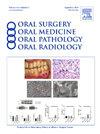Massive intraosseous salivary gland choristoma—radiographically visible cluster of five mucous glands in mandibular marrow
IF 1.9
3区 医学
Q2 DENTISTRY, ORAL SURGERY & MEDICINE
Oral Surgery Oral Medicine Oral Pathology Oral Radiology
Pub Date : 2025-07-21
DOI:10.1016/j.oooo.2025.04.014
引用次数: 0
Abstract
Introduction
Since first described in 1994, ectopic salivary glands (choristomas) have been reported in jawbone marrow in 19 patients, 14 in a single 2000 paper. Such entities, once described, provided for the first time a very logical nonodontogenic tissue of origin for intraosseous salivary neoplasms and cysts. Two reported choristomas were large enough to be radiographically visible. We present herein the largest, most “mature” example yet of this phenomenon.
Methods and Materials
Case report.
Results
An 18-year-old male had his impacted mandibular third molars removed, along with pericoronal cysts. An incidental finding just distal to the left third molar presented as an oval radiolucency with a faint, hazy, reticulated opacity and well-demarcated, scalloped borders. The area was asymptomatic, and the cortex was not expanded. Microscopic examination demonstrated a cyst lining of thin, atrophic stratified squamous epithelium consistent with dentigerous (eruption) cyst. Slightly separated from the cyst was a tight cluster of five independent (as per cut levels) mucous glands without serous demilunes, identical to minor salivary glands except for a lack of excretory ducts. The largest gland was 1.3 × 0.6 × 0.3 cm in size, more than twice as large as any previously described. The glands appeared histologically normal and even contained mucus (mucicarmine positive) in some ducts, something not previously reported. Serial sectioning showed no ducts traversing between glands. The glands were embedded within a mature fibrous stroma, with no true encapsulation noted; inflammation was not seen.
Conclusion
We report the largest yet example of the rare entity, intraosseous salivary choristoma (normal tissue in an abnormal location). This is only the second example to contain multiple glands, the third to show radiographically and the most “normal” gland yet, with ducts and mucus production, as demonstrated by secretions in some ducts. Glands were embedded in fibrous tissue.
巨大的骨内唾液腺绒毛瘤:下颌骨骨髓中放射可见的5个粘液腺集群
自1994年首次报道以来,已有19例患者在颌骨骨髓中报道异位唾液腺(绒毛瘤),其中14例在2000年的一篇论文中报道。这样的实体,一旦被描述,第一次为骨内唾液肿瘤和囊肿提供了一个非常合乎逻辑的非牙源性组织起源。两例报道的脉络膜瘤大到足以在x线摄影上可见。我们在这里给出了这一现象的最大、最“成熟”的例子。方法与材料:病例报告。结果1例18岁男性患者的下颌阻生第三磨牙及冠状周围囊肿均已切除。偶然发现左第三磨牙远端呈椭圆形透光,模糊,网状不透明,边界清晰,呈扇形。该区域无症状,皮质未扩张。镜下检查显示囊肿内层薄,萎缩的层状鳞状上皮与牙疹性囊肿一致。与囊肿稍微分开的是由5个独立的粘液腺组成的紧密集群,没有半乳浆液,除了缺乏排泄管外,与小唾液腺相同。最大的腺体大小为1.3 × 0.6 × 0.3 cm,是先前描述的两倍多。腺体在组织学上表现正常,甚至在一些导管中含有粘液(粘胺阳性),这是以前未报道的。连续切片显示腺体间无导管。腺体包埋在成熟的纤维间质中,未见真正的包封;未见炎症。结论我们报告了迄今为止最大的一例罕见的实体,骨内唾液脉络瘤(正常组织在异常位置)。这是第二个包含多个腺体的例子,第三个在x光片上显示,也是最“正常”的腺体,有导管和粘液产生,如一些导管中的分泌物所示。腺体嵌在纤维组织中。
本文章由计算机程序翻译,如有差异,请以英文原文为准。
求助全文
约1分钟内获得全文
求助全文
来源期刊

Oral Surgery Oral Medicine Oral Pathology Oral Radiology
DENTISTRY, ORAL SURGERY & MEDICINE-
CiteScore
3.80
自引率
6.90%
发文量
1217
审稿时长
2-4 weeks
期刊介绍:
Oral Surgery, Oral Medicine, Oral Pathology and Oral Radiology is required reading for anyone in the fields of oral surgery, oral medicine, oral pathology, oral radiology or advanced general practice dentistry. It is the only major dental journal that provides a practical and complete overview of the medical and surgical techniques of dental practice in four areas. Topics covered include such current issues as dental implants, treatment of HIV-infected patients, and evaluation and treatment of TMJ disorders. The official publication for nine societies, the Journal is recommended for initial purchase in the Brandon Hill study, Selected List of Books and Journals for the Small Medical Library.
 求助内容:
求助内容: 应助结果提醒方式:
应助结果提醒方式:


